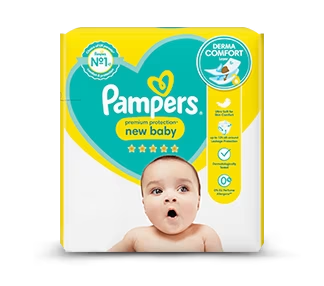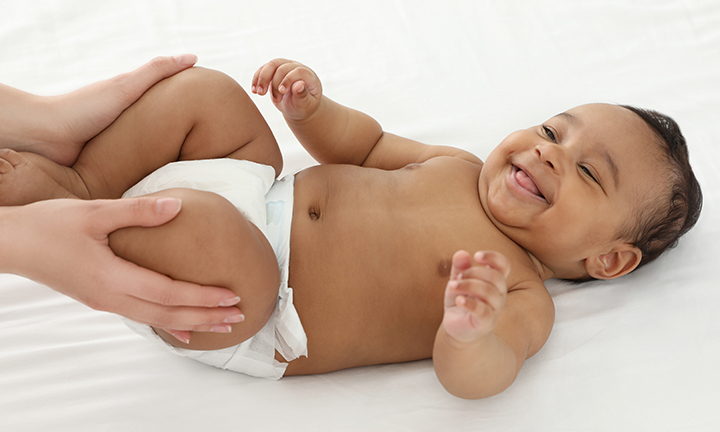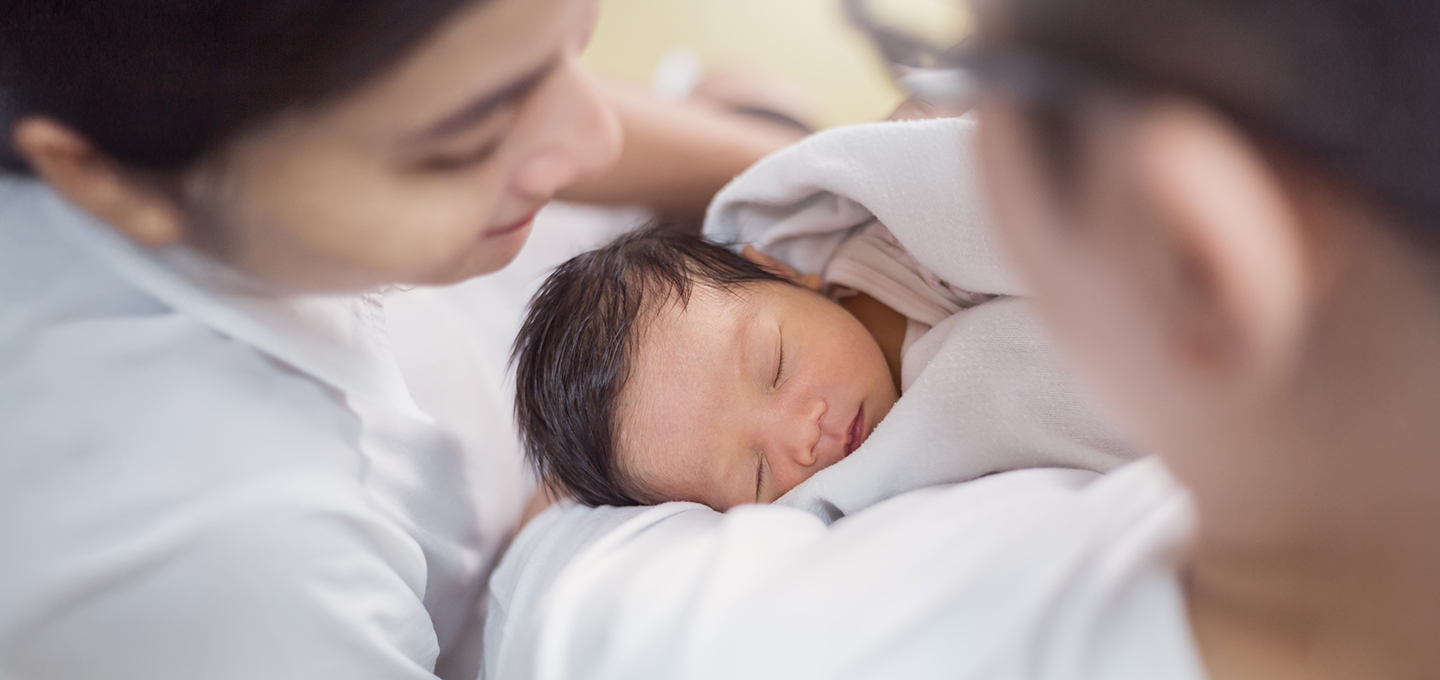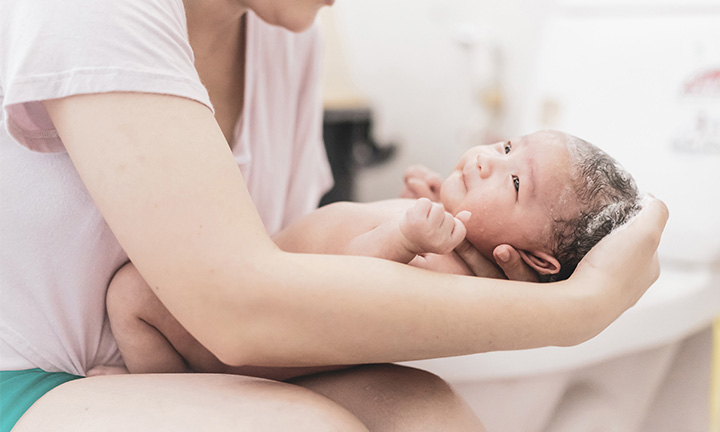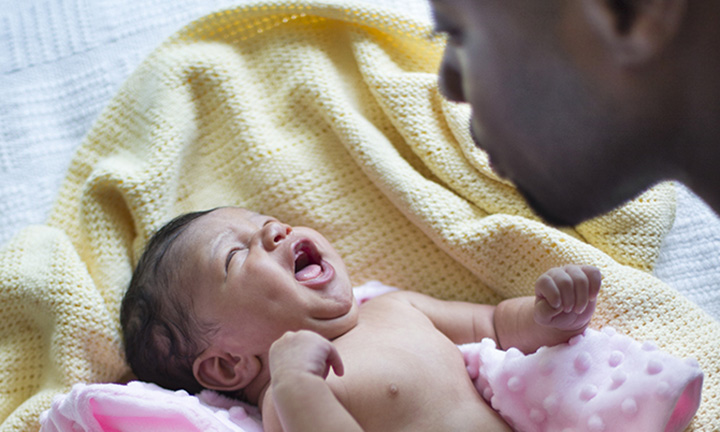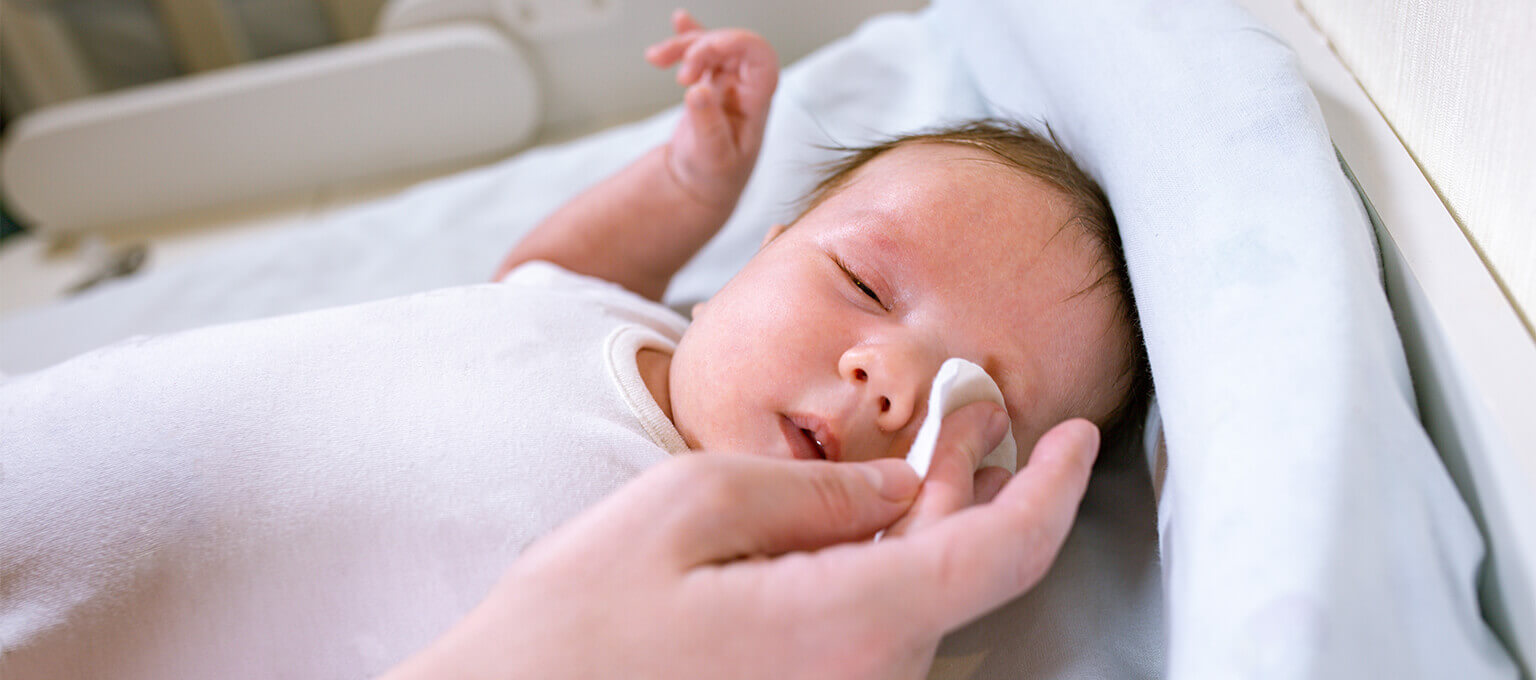
How to Hold a Baby
Being able to hold your baby in your arms at last can be a magical moment. Still, it’s perfectly natural to feel uncertain about how to hold a newborn baby or even a little nervous about it, especially if you’re a first-time parent. Read on for practical advice on how to hold your baby safely after feeding, while bottle-feeding, breastfeeding, bathing, burping or comforting your newborn and in many other situations.
How to Safely Hold a Baby
If you feel a little nervous when it comes to holding your newborn baby for the first time, you’re not alone – plenty of mums (and their partners) feel this way! Don’t worry, you’ll soon get the hang of it. There are a few things to keep in mind when holding your baby. In the following sections we break them down for you depending on the situation. The most important step when carrying or holding your newborn is to support your baby’s head and neck at all times. Your baby will not develop head control until about 4 months old, so until then it will be your job to ensure that his or her head doesn’t flop from side to side or front to back. In the meantime, giving your baby plenty of supervised tummy time every day will help your infant develop the neck muscles needed to hold his or her head up unassisted.
How to Pick Up Your Baby
Before picking up your baby – for example, when you take your child out of a cot – be sure to support the head and neck, taking extra care around the fontanelles (soft spots). When picking up your baby, slide one hand under his head and neck, and place your other hand under his bottom. Bend your knees to avoid straining your back. Now your baby’s head, neck and spine are supported, scoop your little one up and bring him or her close to your chest while you straighten out your legs.
How to Hold Your Baby Cradled in Your Arms
To safely hold your baby in a lengthways position, cradle the head gently in one hand and rest it against your chest for extra support. Use your other forearm to support the neck while placing your baby’s head in the crook of your elbow. Support the bottom with your other hand. This position is great for making eye contact, smiling and talking to your baby, which can aid development and enhance emotional security. Interacting with your baby like this can also help with bonding.
How to Hold Your Baby Upright
You might want to hold your baby upright after a feed to ease the symptoms of reflux or while burping, or just to give him or her a great view of the world.
To hold your infant in this position, support the head and neck with one hand while resting your baby on your chest and shoulder. Support your baby’s bottom with your other hand.
How to Hold Your Baby During Skin-to-Skin Contact
Skin-to-skin contact, also known as kangaroo care, is a bonding practice you can begin right after your baby is born (and continue throughout infancy). Skin-to-skin contact involves placing your baby naked (or just in a nappy and a hat) on your bare chest, with your newborn’s chest touching yours. Drape a blanket or a gown over your baby’s back to keep the warmth in. Skin-to-skin contact not only makes for a great bonding experience but also helps regulate your baby’s temperature, breathing, and heartbeat. But the benefits don’t stop there. Reducing your baby’s anxiety and stress promotes brain development, and the close contact also encourages your child to feed. Meanwhile, breastfeeding mums may experience an increase in breast milk supply.
How to Hold a Baby With Colic
Colic is the term used to describe a period (usually your baby’s first three or four months) when an otherwise healthy baby cries inconsolably for no apparent reason. Colic is often suspected if the crying lasts more than three hours a day, three days a week, for at least one week. It can be tough to know what to do if your baby has colic, especially when nothing seems to work. One of the methods you can try is cuddling your baby to soothe the crying. Rocking your baby in your arms may also help, as can holding her close to you in a baby carrier. Looking after a baby with colic can be stressful. If you feel unable to cope with colicky crying:
Put your baby down safely (for example in the cot on his or her back), and take a short break to calm down before re-entering the room
Ask your family, friends or parents for support
Speak to your health visitor of GP
Never shake your baby under any circumstances.
How to Hold a Baby With Acid Reflux
Reflux is a common cause of discomfort in babies. It happens when a little milk or formula comes back up again after a feed, sometimes mixed in with a little stomach acid.
It usually starts in the first two months and clears up by itself with time as your baby’s digestive system develops, but until then it can sometimes make feeds less enjoyable for your little one and you. Holding your baby upright during a feed, and for as long as possible afterwards, can help ease the discomfort of reflux. Symptoms of reflux can in your baby can include:
How to Hold a Baby While Bottle-Feeding
When bottle-feeding, whether it’s with formula or breast milk, cradle your baby in a semi-upright position (to help with swallowing), supporting the head in the crook of your arm and the body along your inner forearm. Avoid holding your baby completely horizontally during a feed, as this can create a choking risk. Also, don’t let your baby fall asleep with a bottle, which can lead to ear infections and tooth decay. Keeping the bottle almost horizontal – just tipping it very slightly – will keep the milk flowing and help stop your baby swallowing air.
How to Hold Your Baby While Breastfeeding
There are several ways to hold your baby while breastfeeding. You might use one or several of them depending on which works best for you in a given situation. Here are three of the most common breastfeeding positions you can try:
Cradle hold. This is the most traditional hold and probably the one most mums try first.
Cradle your baby with the arm that’s on the same side as the breast your baby will be feeding from.
Rest your infant’s head in the crook of your arm, body and face turned inward towards you.
Use your hand to support the length of your infant’s body. Put your baby’s lower arm under yours. If your baby’s ear, shoulder and hip are in a straight line, your baby is in the right position
Gently guide your baby’s head to your breast.
Rugby hold. As you’d imagine, this position has you tucking your baby under your arm a little like a rugby ball. It could be ideal if you’re recovering after a caesarean section, if you have large breasts or inverted nipples, or if you’ve given birth to twins and want to feed both babies at the same time.
Sit down in a chair with a cushion or pillow next to you.
Position your infant under your arm on the side you want to feed from, with your baby’s hips close to yours.
If your baby’s nose is close to your nipple, you’re ready to start feeding.
Supporting your baby’s neck with your hand, gently guide your little one to your breast.
Side-lying position. This is another good position to try if you’ve had a caesarean section. You might also find it a convenient one for late-night feeds –just make sure you put your baby back in the cot after the feed.
Lie comfortably on your side and place your baby beside you, facing you.
Tuck your lower arm under your head or a pillow (taking care to keep the pillow well of your baby’s face) and use the other arm to support your baby’s head and guide it towards your breast.
How to Hold a Baby When Burping
Here are three common ways to hold your baby for a burping session. Use the one that works best for your baby:
How to Hold a Baby When Bathing
When bathing your baby, be sure to support your child’s head with one hand while you use your other hand to guide your infant into the baby bathtub or basin. Make sure to keep most your baby’s head clear of the water with one hand, while using the other to wash him or her by gently swishing the water. Don’t let go of your baby or leave him or her unattended even for a moment.
How to Hold a Baby When Feeding With Solid Foods
Introducing solid foods is recommended from around 6 months old. When you feed your child solid food, it’s important to make sure your baby is sitting upright. This allows your baby to swallow properly and helps minimise the risk of choking. It also helps prepare your child for joining the family at the table (if he or she doesn’t already take part in family mealtimes). Support your baby in your lap in an upright position or, if he or she can sit unsupported, in a highchair fitted with a safety harness. Never leave your child unattended in the highchair or on any raised surface. Don’t leave your baby alone with food.
How Not to Hold a Baby
When holding your little one, focus on your baby and avoid trying to multitask. Take special care not to do anything that could be potentially dangerous. For example, never handle hot drinks or cook while holding your baby. Tread carefully while carrying your baby and keep an eye on where you put your feet to avoid tripping over misplaced toys and other obstacles. Never shake your baby If your little one is crying and you’re feeling frustrated, it’s important never to shake your baby. Shaking or roughly handling a baby can cause serious injury or death. If you feel you’ve run out of patience, place your child safely on his or her back in the cot, and take some time out in another room for a few minutes. Re-enter the room when you’re feeling calm and ready. Reach out to friends and family or ask your health visitor for support if you feel unable to cope.
Letting Friends and Family Hold Your Baby
When it comes to friends and family holding your newborn baby, rather than hand them your baby while they’re standing it may be safer to ask them to sit down – then gently place your baby in their arms, ready for cradling. Some other important tips to keep in mind:
Safety Tips for You When You Hold Your Baby
As you master holding your baby in the correct way, it’s also important to pay attention to your own posture while holding your child. Your baby may seem feather-light at the moment, but even now regularly picking up, putting down and carrying your child can increase your risk of pain from injury or strain. As your baby grows in size and weight, the chances of straining your muscles and joints will also increase, so it’s important to get into good habits from the very beginning. To avoid injury, aim to carry your baby close to and centred on your body. Avoid carrying your baby on your hip as this can cause shoulder, hip, and spine problems. If you need to turn while holding your baby, turn with your feet rather than twisting at the waist or spine. To properly carry and lift your baby, keep your
When picking up your baby up from a lower spot like the crib or play mat,
FREQUENTLY ASKED QUESTIONS
As long as you support your newborn’s head and neck as all times, there are plenty of ways to hold your baby, including:
- Cuddled up close
- Cradled lengthways in your arms
- Upright looking over your shoulder
- In a sling.
The Bottom Line
Holding your baby for the first time might seem daunting if you’re a new parent, but before long it will become second nature – all you need to do is follow a few simple guidelines. The most important thing is always to support your baby’s head and neck and avoid distractions or multi-tasking while holding or carrying your little one. Whether you’re feeding your baby, burping, or practicing skin-to-skin contact, the simple holds we’ve described above should help ensure both of you are comfortable and safe. Holding your baby is a wonderful thing — these are the moments that will bond the two of you for a lifetime. Enjoy the cuddles!
The information in this article is based on the expert advice found in trusted medical and government sources, such as the National Health Service (NHS). You can find a full list of sources used for this article below. The content on this page should not replace professional medical advice. Always consult medical professionals for full diagnosis and treatment.
- NHS: Handle with Care
- NHS: Milestones
- NHS: Baby moves
- NHS: Safe lifting
- NHS: Kangaroo care (skin to skin contact)
- NHS: Colic
- NHS: Reflux in babies
- NHS: Bottle feeding
- NHS: Breastfeeding positions
- NHS: Positioning
- NHS: Burping your baby
- NHS: Washing and bathing your baby
- NHS: Baby’s first solid foods
- NHS: Baby and toddler safety
- NHS: Keeping your baby clean and healthy
- NHS: Your guide to lateral hip pain
Read more about Newborn Baby
Related Articles
Join Pampers Club and get:

